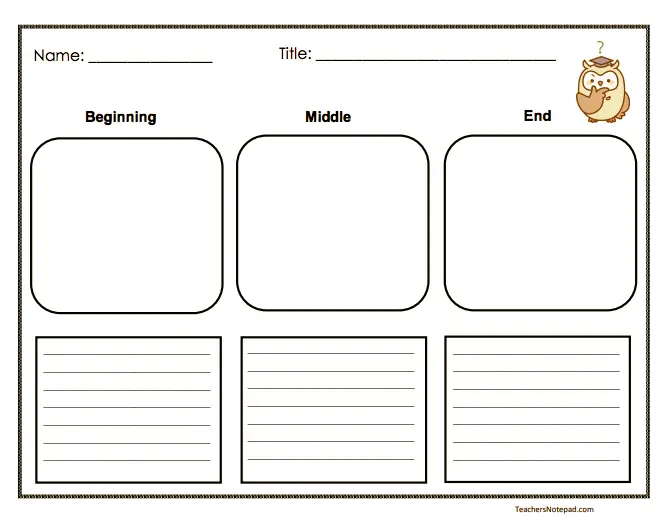When we are teaching our students reading or writing skills there are numerous techniques we can use to help guide their thought process.
One such method which I’ve used to great effect over the years with my students is the “Beginning Middle End” graphic organizer.
This allows me to easily guide the kids to think about the different phases of a story or narrative, and allow them to better understand (or create their own) story arcs.
Reading
How to use this resource for reading?
We can use a Beginning Middle End worksheet to help students summarise a text after they have read it.
We might frame this for them simply by asking what the key points from the beginning middle and end are to them.
We’ll allow them some space to draw a picture, and to write their notes, for each of the three sections.
An alternative method of using this resource is to provide it to your students before reading the text, and ask them to predict what they think might happen through the three phases.
Then, after reading the story for example, they can add to this in a different color, and can very easily see the differences for themselves.
What ages can use it for reading?
These can be used from the very beginning of schooling.
For example, picture books can be used in conjunction with this worksheet for Grade 1 / Grade 2.
Typically this type of resource is most often used with fiction short stories.
For younger students you could provide 3 pictures from the beginning, middle and end – for example while preparing to read a wonderful children’s picture book such as The Gruffalo, and the children could then stick those pictures where they think they go in the story. They could then write a short sentence underneath it explaining what is happening in this part of the story.
For Grade 3 and upwards this worksheet can be used as an independent follow up activity (or activity station). The students can read their chosen story and go on to complete the graphic organiser – perhaps then talking through their summary with the class.

Writing
How to use this resource for writing?
While this kind of printable is most commonly used to accompany reading, it can also be used as a planner for a narrative.
You might ask the kids a question such as “what key things will happen in the beginning, middle, and end of your story?” to help encourage your aspiring writers to be thoughtful about how they would like their story to start, build, and end.
I find it very useful in addition to printing a copy for each student in A4/letter size, to also display an A3/tabloid sized version on the board for the entire class to see.
What ages can use this for writing?
A beginning / middle / end worksheet is actually a useful resource even for younger students who are not yet able to write their own stories.
From the kindergarten and first grade level you might use a children’s picture book (again, I have to recommend The Gruffalo!), and print 3 pictures to use.
Then simply ask the children to help you decide whether those pictures belong at the beginning, middle, or end of the new story you’re all helping create.
You could then ask for suggestions about what to write underneath to describe the picture, and what happens in the story. This gives them ideas for writing their own stories with a beginning, middle, and end.
For older elementary/primary students you can guide them to use the 3 boxes for planning out their own story.
Sometimes I’ll encourage these students to come up with their own concepts, while other times for variation I’ll provide some of my own story ideas to inspire them. (It’s always really entertaining to see how varied the resulting stories can be as well!)
This can include a beginning/middle/end component for several different aspects of their story, from core story ideas, vocabulary that they want to include, characters to make appearances, and the overall storyline arc.
They can use the lines underneath to write the beginning of the sentences, and draw pictures to go with their plans in the boxes.
In this way it almost becomes a basic storyboard outline – a great method of allowing students to think about what their story will encompass.
Free printable PDF worksheet

Community feedback
We love to hear from our community of teachers, so please feel free to get in touch and share the interesting ways you’re using our free resources 🙂
A lot of teachers have been finding our free easy grader calculator very useful too, so you’ll want to check that out while you’re here!
As always, make sure you bookmark and Pin so you can check back and get all the useful worksheets and other goodies we make and publish for you each week!
Thanks
Matt & Hayley

